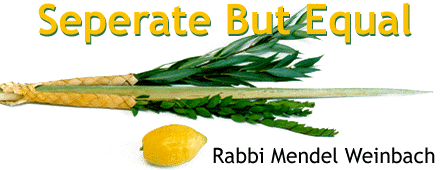Separate But Equal

The relationship of each of the four species with one another is fascinating. It is impossible to fulfill the mitzvah of taking them on Succos unless you have all of them. This indicates unity. Yet each of the species has its own individual character.
The gemara (Menachos 27a) breaks them down into categories - the lulav and esrog from trees which produce fruit and the hadas and arava from trees which do not. The Midrash makes an even finer distinction in assigning to the esrog the qualities of taste and fragrance, the lulav taste (dates) with no fragrance, the hadas fragrance without taste, and the arava devoid of both.
Taste and smell symbolize Torah knowledge and good deeds. There are four kinds of Jews corresponding to these species - those with both Torah and good deeds, those with Torah but lacking good deeds, those with good deeds but lacking Torah, and those who lack both. The message in both the gemara and Midrash is that Hashem commanded us to take all four species to symbolize the need for all the different components of the Jewish People to unite when crying out to Him in a time of trouble and when celebrating in a Festival time of joy.
Such a need for unity might lead us to think that all four species should actually be bound together into one unit. Rabbi Eliezer points out that an analysis of the passage (Vayikra 22:40) indicates that the esrog must be separate from the other three. The Torah connects the lulav, hadas and arava with a connecting prefix which translates as "and," but does not connect the esrog with this group. This is why we bind together those three and take them in the right hand, because they are three in number and deserving of being taken by the more important hand, while we take the esrog alone with our left hand.
If unity is so crucial, it may be asked, why did the Torah order us to keep the esrog, symbolizing the righteous Torah scholar with both taste and fragrance, separate from the three other species which are so dependent on his influence?
It has been suggested that in this balance between unity and separation lies the formula for successful interaction between the religious leader and those whom he wishes to teach and inspire. The esrog must be careful to maintain his standards and not lower them out of a desire to achieve greater social acceptability. Maintaining this distance must not, however, lead him to abandon his responsibility to enrich the other species with his own taste and fragrance. All four species must therefore be taken together, three in one hand and one in the other, to achieve this perfect blend.
- Succah 34b






